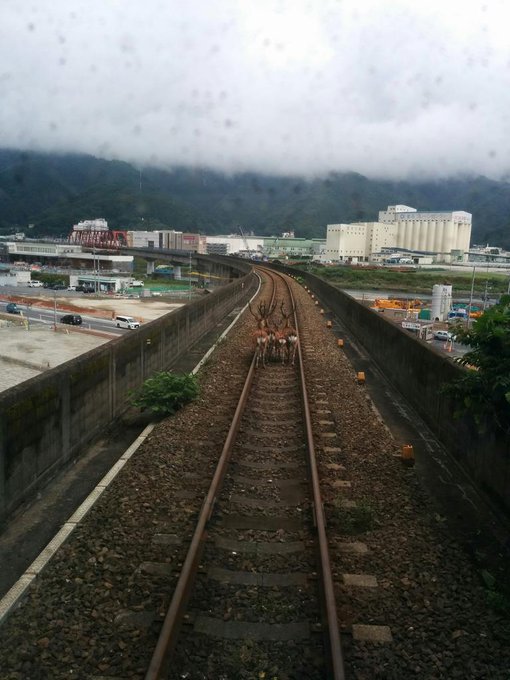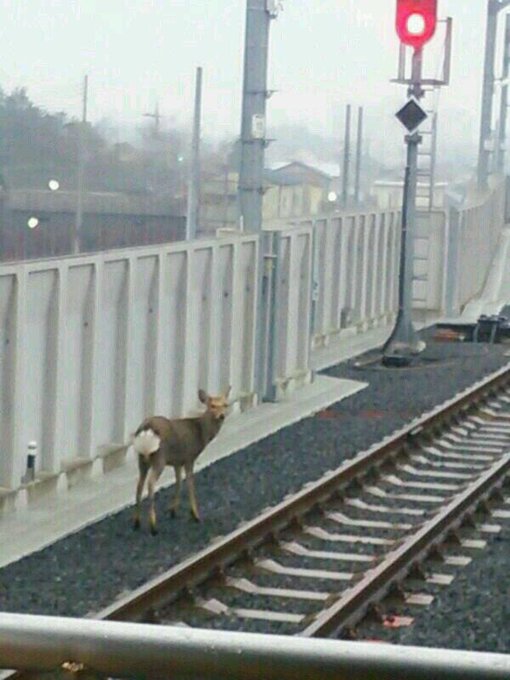Author
RUSSELL MCLENDON

 An illustration of the ultrasonic deterrent system, with gates open (left) and closed (right). (Image: GDA/JIDP)
An illustration of the ultrasonic deterrent system, with gates open (left) and closed (right). (Image: GDA/JIDP)
 Researchers hope to test snorting and barking trains more widely in Japan. (Photo: Yungram Yongyut/Shutterstock)
For further information log on website :
Researchers hope to test snorting and barking trains more widely in Japan. (Photo: Yungram Yongyut/Shutterstock)
For further information log on website :
https://www.mnn.com/green-tech/research-innovations/blogs/japanese-trains-save-deer-sound-effects
RUSSELL MCLENDON
Rail systems have trains that bark, snort and emit ultrasonic waves.

An employee for Kintetsu Railway invented a system to deter deer with ultrasonic waves after he saw a fawn killed by a train. The idea won Japan's Good Design Award in 2017. (Photo: Good Design Award/Japan Institute of Design Promotion)
Japan's rail system is world-famous for its precision. Trains carry several billion people throughout the country every year with uncanny exactness, rarely deviating from their schedules by more than a few seconds.
Yet even in this utopia of locomotive reliability, trains face an age-old problem for rail transit: animals on the tracks. And with roughly 20,000 kilometers (12,000 miles) of tracks across Japan, keeping wildlife away from railways can be a daunting task.
Trains hit wildlife a record 613 times in 2016, according to Japan's Ministry of Land, Infrastructure, Transport and Tourism, each leading to delays of at least 30 minutes. On top of that, of course, is the generally dire outcome for the animals themselves.
There is a risk with animals as small as turtles, which caused at least 13 rail disruptions between 2002 and 2014 in western Nara prefecture alone. But, as MNN's Matt Hickman reported in 2015, West Japan Railway Co. (JR West) worked with researchers from Suma Aqualife Park in Kobe to develop a simple solution: custom trenches that let the turtles pass safely underneath the tracks.
Japanese trains must also co-exist with larger, more dangerous trespassers than turtles. Deer have become especially troublesome in certain parts of the country, sometimes even seeming to actively seek out railway lines. Many are likely just trying to move around their habitat in search of food or mates, but the deer are also reportedly attracted to the lines due to a need for iron in their diets, licking up small iron filings left behind by the grinding of train wheels on the tracks.
People have tried a variety of tactics to rid railways of deer, from setting up physical barriers and alternative iron sources to spreading lion feces on the tracks. The latter plan was abandoned, reportedly both because its smell was too strong to use in residential areas and because it was easily washed away by rain. Deer have repeatedly defied ropes, fences, flashing lights and many other deterrents.
Recently, however, two new tactics have raised hopes for reducing deer collisions:
Ultrasonic waves
Yuji Hikita, an employee of an electricity division at Kintetsu Railway Co., watched a heartbreaking scene in 2015 caught by surveillance video on Kintetsu's Osaka Line. A family of deer entered the tracks at night, and one of three fawns at the rear of the group was struck and killed by a train. A parent deer stared down at the fallen fawn for 40 minutes, according to the Asahi Shimbun newspaper.
After seeing that, Hikita racked his brain for ways to stop it from happening so often. Deer collisions have been on the rise for many of Kintetsu's mountainous rail lines, the Asahi Shimbun reports, noting the total grew from 57 in 2004 to 288 in 2015.
"Despite all our efforts to shut out deer, they still enter the tracks," he thought at the time, as he tells the Asahi Shimbun. "Why don't we have crossings for deer?"
Hikita began to study the deer, finding hoof prints and dung along both sides of the tracks. He came up with an idea, and two years later, that idea won a 2017 Good Design Award from the Japan Institute of Design Promotion.
 An illustration of the ultrasonic deterrent system, with gates open (left) and closed (right). (Image: GDA/JIDP)
An illustration of the ultrasonic deterrent system, with gates open (left) and closed (right). (Image: GDA/JIDP)
It's already in use on part of the Osaka Line, where netting rises 2 meters high (about 6.5 feet) alongside the tracks, except for periodic 20- to 50-meter gaps (about 65 to 165 feet). In those gaps, ultrasonic waves form temporary barriers at the riskiest times around dawn and dusk, but not when trains are offline overnight. And since humans can't hear the sound, it's less upsetting in residential areas than lion dung.
Three of these crossings have been set up on the Osaka Line in a mountainous area of Tsu, the capital of Mie Prefecture, according to the Asahi Shimbun. That section of track suffered 17 deer collisions in fiscal 2015, but only one has been reported there since the deer crossings were installed more than a year ago.
Kintetsu also added deer crossings on a different stretch of the same line in Nara Prefecture, where deer accidents fell from 13 in 2016 to two within eight months. "This is an excellent example of how railway companies can tackle the deer-train collision problem from the deer's perspective," a judge for the Good Design Award said in 2017, "and it owes to the countless number sacrificed in the accidents."
The idea still needs wider testing, but it has already drawn interest from some other rail companies. JR West, for one, began testing the deer crossings at a section of its Sanyo Line in Okayama Prefecture last year, the Asahi Shimbun reports.
Snorting and barking
 Researchers hope to test snorting and barking trains more widely in Japan. (Photo: Yungram Yongyut/Shutterstock)
Researchers hope to test snorting and barking trains more widely in Japan. (Photo: Yungram Yongyut/Shutterstock)
In another inventive approach, researchers with the Railway Technical Research Institute (RTRI) have been testing trains that snort like a deer and bark like a dog.
This combination of sounds turns out to be a good way to scare deer, the BBC reports. First, a three-second blast of deer-snort noises gets their attention, followed by a 20-second clip of barking dogs, which is apparently enough to make them flee.
RTRI officials say the results have been encouraging so far, with deer sightings down about 45 percent on trains that snort and bark. The idea plays on natural deer behavior, which includes "a habit of repeatedly snorting short, shrill sounds to alert other deer when they perceive danger," according to the Asahi Shimbun.
The institute hopes to conduct broader experiments of the system, and if it proves effective, possibly set up stationary devices to snort and bark along the tracks in places where deer are commonly seen. The noises would reportedly not be blared where near people's homes are near the tracks, however.
https://www.mnn.com/green-tech/research-innovations/blogs/japanese-trains-save-deer-sound-effects









No comments:
Post a Comment